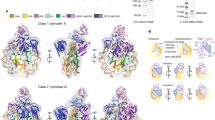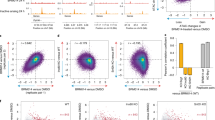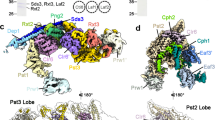Abstract
We report a novel chromatin-modulating factor, nuclear FK506-binding protein (FKBP). It is a member of the peptidyl prolyl cis-trans isomerase (PPIase) family, whose members were originally identified as enzymes that assist in the proper folding of polypeptides. The endogenous FKBP gene is required for the in vivo silencing of gene expression at the rDNA locus and FKBP has histone chaperone activity in vitro. Both of these properties depend on the N-terminal non-PPIase domain of the protein. The C-terminal PPIase domain is not essential for the histone chaperone activity in vitro, but it regulates rDNA silencing in vivo. Chromatin immunoprecipitation showed that nuclear FKBP associates with chromatin at rDNA loci in vivo. These in vivo and in vitro findings in nuclear FKBPs reveal a hitherto unsuspected link between PPIases and the alteration of chromatin structure.
This is a preview of subscription content, access via your institution
Access options
Subscribe to this journal
Receive 12 print issues and online access
$189.00 per year
only $15.75 per issue
Buy this article
- Purchase on Springer Link
- Instant access to full article PDF
Prices may be subject to local taxes which are calculated during checkout







Similar content being viewed by others
References
Workman, J.L. & Kingston, R.E. Alteration of nucleosome structure as a mechanism of transcriptional regulation. Annu. Rev. Biochem. 67, 545–579 (1998).
Wolffe, A. Chromatin 3rd edn (Academic, San Diego, 1998).
Fan, Z., Beresford, P.J., Oh, D.Y., Zhang, D. & Lieberman, J. Tumor suppressor NM23-H1 is a granzyme A-activated DNase during CTL-mediated apoptosis, and the nucleosome assembly protein SET is its inhibitor. Cell 112, 659–672 (2003).
Ito, T., Bulger, M., Pazin, M.J., Kobayashi, R. & Kadonaga, J.T. ACF, an ISWI-containing and ATP-utilizing chromatin assembly and remodeling factor. Cell 90, 145–155 (1997).
Seo, S. et al. Regulation of histone acetylation and transcription by INHAT, a human cellular complex containing the Set oncoprotein. Cell 104, 119–130 (2001).
Galat, A. & Riviere, S. Peptidyl-prolyl cis/trans Isomerases (Oxford Univ. Press, Oxford, 1998).
Hunter, T. Prolyl isomerase and nuclear function. Cell 92, 141–143 (1998).
Himukai, R., Kuzuhara, T. & Horikoshi, M. Relationship between the subcellular localization and structures of catalytic domains of FKBP-type PPIases. J. Biochem. 126, 879–888 (1999).
Leverson, J.D. & Ness, S.A. Point mutations in v-Myb disrupt a cyclophilin-catalyzed negative regulatory mechanism. Mol. Cell 1, 203–211 (1998).
Mamane, Y., Sharma, S., Petropoulos, L., Lin, R. & Hiscott, J. Posttranslational regulation of IRF-4 activity by the immunophilin FKBP52. Immunity 12, 129–140 (2000).
Pratt, W.B. Control of steroid receptor function and cytoplasmic-nuclear transport by heat shock proteins. Bioessays 14, 841–848 (1992).
Tai, P.K., Albers, M.W., Chang, H., Faber, L.E. & Schreiber, S.L. Association of a 59-kiloDalton immunophilin with the glucocorticoid receptor complex. Science 256, 1315–1318 (1992).
Sinars, C.R. et al. Structure of the large FK506-binding protein FKBP51, an Hsp90-binding protein and a component of steroid receptor complexes. Proc. Natl. Acad. Sci. USA 100, 868–873 (2003).
Rycyzyn, M.A. & Clevenger, C.V. The intranuclear prolactin/cyclophilin B complex as a transcriptional inducer. Proc. Natl. Acad. Sci. USA 99, 6790–6795 (2002).
Lu, P.-J., Wulf, G., Zhou, X.Z., Davies, P. & Lu, K.P. The prolyl isomerase Pin1 restores the function of Alzheimer-associated phosphorylated tau protein. Nature 399, 784–788 (1999).
Lavoie, S.B., Albert, A.L., Handa, H., Vincent, M. & Bensaude, O. The peptidyl-prolyl isomerase Pin1 interacts with hSpt5 phosphorylated by Cdk9. J. Mol. Biol. 312, 675–685 (2001).
Zacchi, P. et al. The prolyl isomerase Pin1 reveals a mechanism to control p53 functions after genotoxic insults. Nature 419, 853–857 (2002).
Zheng, H. et al. The prolyl isomerase Pin1 is a regulator of p53 in genotoxic response. Nature 419, 849–853 (2002).
Ryan, K.M. & Vousden, K.H. Cancer: pinning a change on p53. Nature 419, 795–797 (2002).
Shan, X., Xue, Z. & Melese, T. Yeast NPI46 encodes a novel prolyl cis/trans isomerase that is located in the nucleolus. J. Cell Biol. 126, 853–862 (1994).
Arévalo-Rodríguez, M., Cardenas, M.E., Wu, X., Hanes, S.D. & Heitman, J. Cyclophilin A and Ess1 interact with and regulate silencing by the Sin3-Rpd3 histone deacetylase. EMBO J. 19, 3739–3749 (2000).
Wu, X. et al. The Ess1 prolyl isomerase is linked to chromatin remodeling complexes and the general transcription machinery. EMBO J. 19, 3727–3738 (2000).
Yang, W.-M., Yao, Y.-L. & Seto, E. The FK506-binding protein 25 functionally associates with histone deacetylases and with transcription factor YY1. EMBO J. 20, 4814–4825 (2001).
Laskey, R.A., Honda, B.M., Mills, A.D. & Finch, J.T. Nucleosome are assembled by an acidic protein which binds histones and transfers them to DNA. Nature 275, 416–420 (1978).
Ishimi, Y., Yasuda, H., Hirosumi, J., Hanaoka, F. & Yamada, M. A protein which facilitates assembly of nucleosome-like structure in vitro in mammalian cells. J. Biochem. 94, 735–744 (1983).
Harding, M.W., Galat, A., Uehling, D.E. & Schreiber, S.L. A receptor for the immunosuppressant FK506 is a cis/trans peptidyl-prolyl isomerase. Nature 341, 758–760 (1989).
Siekierka, J.J., Hung, S.H.Y., Poe, M., Lin, C.S. & Sigal, N.H. A cytosolic binding protein for the immunosuppressant FK506 has peptidyl-prolyl isomerase activity but is distinct from cyclophilin. Nature 341, 755–757 (1989).
Kleinschmidt, J.A. & Franke, W.W. Soluble acidic complexes containing histones H3 and H4 in nuclei of Xenopus laevis oocytes. Cell 29, 799–809 (1982).
Matsumoto, K., Nagata, K., Ui, M. & Hanaoka, F. Template activating factor I, a novel host factor required to stimulate the adenovirus core DNA replication. J. Biol. Chem. 268, 10582–10587 (1993).
Kaufman, P.D., Kobayashi, R. & Stillman, B. Ultraviolet radiation sensitivity and reduction of telomeric silencing in Saccharomyces cerevisiae cells lacking chromatin assembly factor-I. Genes Dev. 11, 345–357 (1997).
Tyler, J.K. et al. The RCAF complex mediates chromatin assembly during DNA replication and repair. Nature 402, 555–560 (1999).
Munakata, T., Adachi, N., Yokoyama, N., Kuzuhara, T. & Horikoshi M. A human homologue of yeast anti-silencing factor has histone chaperone activity. Genes Cells 5, 221–233 (2000).
Chimura, T., Kuzuhara, T. & Horikoshi, M. Identification and characterization of CIA/ASF1 as an interactor of bromodomains associated with TFIID. Proc. Natl. Acad. Sci. USA 99, 9334–9339 (2002).
Umehara, T., Chimura, T., Ichikawa, N. & Horikoshi, M. Polyanionic stretch-deleted histone chaperone cia1/Asf1p is functional both in vivo and in vitro. Genes Cells 7, 59–73 (2002).
Benton, B.M., Zang, J.H. & Thorner, J. A novel FK506- and rapamycin-binding protein (FPR3 gene product) in the yeast Saccharomyces cerevisiae is a proline rotamase localized to the nucleolus. J. Cell Biol. 127, 623–639 (1994).
Hecht, A., Strahl-Bolsinger, S. & Grunstein, M. Spreading of transcriptional repressor SIR3 from telomeric heterochromatin. Nature 383, 92–96 (1996).
Smith, J.S., Caputo, E. & Boeke, J.D. A genetic screen for ribosomal DNA silencing defects identifies multiple DNA replication and chromatin-modulating factors. Mol. Cell. Biol. 19, 3184–3197 (1999).
Dolinski, K., Muir, S., Cardenas, M. & Heitman, J. All cyclophilins and FK506 binding proteins are, individually and collectively, dispensable for viability in Saccharomyces cerevisiae. Proc. Natl. Acad. Sci. USA 94, 13093–13098 (1997).
Dolinski, K. et al. Functions of FKBP12 and mitochondrial cyclophilin active site residues in vitro and in vivo in Saccharomyces cerevisiae. Mol. Biol. Cell 8, 2267–2280 (1997).
Singer, M.S. et al. Identification of high-copy disruptors of telomeric silencing in Saccharomyces cerevisiae. Genetics 150, 613–632 (1998).
Dittmer, D. et al. Gain of function mutations in p53. Nat. Genet. 4, 42–46 (1993).
Fritze, C.E., Verschueren, K., Strich, R. & Easton Esposito, R. Direct evidence for SIR2 modulation of chromatin structure in yeast rDNA. EMBO J. 16, 6495–6509 (1997).
Ratajczak, T. & Carrello, A. Cyclophilin 40 (CyP-40), mapping of its hsp90 binding domain and evidence that FKBP52 competes with CyP-40 for hsp90 binding. J. Biol. Chem. 271, 2961–2965 (1996).
Lu, P.J., Zhou, X.Z., Shen, M. & Lu, K.P. Function of WW domains as phosphoserine- or phosphothreonine-binding modules. Science 283, 1325–1328 (1999).
Verdecia, M.A., Bowman, M.E., Lu, K.P., Hunter, T. & Noel, J.P. Structural basis for phosphoserine-proline recognition by group IV WW domains. Nat. Struct. Biol. 7, 639–643 (2000).
Zarrinpar, A. & Lim, W.A. Converging on proline: the mechanism of WW domain peptide recognition. Nat. Struct. Biol. 7, 611–613 (2000).
Morris, D.P., Phatnani, H.P. & Greenleaf, A.L. Phospho-carboxyl-terminal domain binding and the role of a prolyl isomerase in pre-mRNA 3′-end formation. J. Biol. Chem. 274, 31583–31587 (1999).
Silverstein, A.M. et al. Different regions of the immunophilin FKBP52 determine its association with the glucocorticoid receptor, hsp90, and cytoplasmic dynein. J. Biol. Chem. 274, 36980–36986 (1999).
Albert, A, Lavoie, S. & Vincent, M. A hyperphosphorylated form of RNA polymerase II is the major interphase antigen of the phosphoprotein antibody MPM-2 and interacts with the peptidyl-prolyl isomerase Pin1. J. Cell Sci. 112, 2493–2500 (1999).
Wu, X., Chang, A., Sudol, M. & Hanes, S.D. Genetic interactions between the ESS1 prolyl-isomerase and the RSP5 ubiquitin ligase reveal opposing effects on RNA polymerase II function. Curr. Genet. 40, 234–242 (2001).
Hoffmann, A. & Roeder, R.G. Purification of his-tagged proteins in non-denaturing conditions suggests a convenient method for protein interaction studies. Nucleic Acids Res. 19, 6337–6338 (1991).
Simon, R.H. & Felsenfeld, G. A new procedure for purifying histone pairs H2A + H2B and H3 + H4 from chromatin using hydroxyapatite. Nucleic Acids Res. 6, 689–696 (1979).
Rothstein, R.J. One-step gene disruption in yeast. Methods Enzymol. 101, 202–211 (1983).
Van Duyne, G.D., Standaert, R.F., Karplus, P.A., Schreiber, S.L. & Clardy, J. Atomic structure of FKBP-FK506, an immunophilin-immunosuppressant complex. Science 252, 839–842 (1991).
Michnick, S.W., Rosen, M.K., Wandless, T.J., Karplus, M. & Schreiber, S.L. Solution structure of FKBP, a rotamase enzyme and receptor for FK506 and rapamycin. Science 252, 836–839 (1991).
Moore, J.M., Peattie, D.A., Fitzgibbon, M.J. & Thomson, J.A. Solution structure of the major binding protein for the immunosuppressant FK506. Nature 351, 248–250 (1991).
Acknowledgements
We thank J. Smith and J.D. Boeke for the gift of the yeast strain JS237 and Y. Ohya for the Candida glabrata genes. We also thank R. Himukai and N. Shinjyo for the construction of SpFkbp39p plasmids and purification of Fpr4 proteins, and N. Adachi, T. Chimura, K. Hasegawa, A. Kimura, S. Muto, M. Ohara, T. Suzuki, T. Umehara and P.A. Weil for critically reading the manuscript. This work was supported in part by a grant-in-aid for scientific research from the Ministry of Education, Culture, Sports, Science and Technology of Japan, New Energy and Industrial Technology Development Organization (NEDO) of the Ministry of Economy, Trade and Industry of Japan, and the Exploratory Research for Advanced Technology (ERATO) of the Japan Science Technology Corporation (JST).
Author information
Authors and Affiliations
Corresponding author
Ethics declarations
Competing interests
The authors declare no competing financial interests.
Supplementary information
Rights and permissions
About this article
Cite this article
Kuzuhara, T., Horikoshi, M. A nuclear FK506-binding protein is a histone chaperone regulating rDNA silencing. Nat Struct Mol Biol 11, 275–283 (2004). https://doi.org/10.1038/nsmb733
Received:
Accepted:
Published:
Issue Date:
DOI: https://doi.org/10.1038/nsmb733
This article is cited by
-
Positive selection analysis reveals the deep-sea adaptation of a hadal sea cucumber (Paelopatides sp.) to the Mariana Trench
Journal of Oceanology and Limnology (2021)
-
Basic surface features of nuclear FKBPs facilitate chromatin binding
Scientific Reports (2017)
-
Nucleoplasmin-like domain of FKBP39 from Drosophila melanogaster forms a tetramer with partly disordered tentacle-like C-terminal segments
Scientific Reports (2017)
-
Recent Perspectives on the Roles of Histone Chaperones in Transcription Regulation
Current Molecular Biology Reports (2017)
-
Human DNA-binding peptidyl-prolyl cis/trans isomerase Par14 is cell cycle dependently expressed and associates with chromatin in vivo
BMC Biochemistry (2015)



